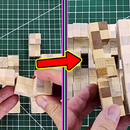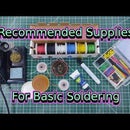Introduction: Soldering Wires to Wires | Soldering Basics
For this Instructable, I'll be discussing common ways for soldering wires to other wires. I'll be assuming that you've already checked out the first 2 Instructables for my Soldering Basics series. If you have not check out my Instructables on Using Solder and Using Flux, I recommend that you do since I'll be applying information from those Instructable in this one.
If you're interested in learning about some other aspects of soldering, you can check out the other Instructables in my Soldering Basics Series:
- Using Solder (Click Here)
- Using Flux (Click Here)
- Soldering Wires to Wires (This one)
- Soldering Through Hole Components (Click Here)
- Soldering Surface Mount Components (Click Here)
- Basic Desoldering (Click Here)
I'm open to adding more topics to this series over time so if you have any suggestions, leave a comment and let me know. Also, if you have any tips to share, or if I get some of my info wrong, please let me know. I want to make sure this Instructable is as accurate and helpful as possible.
If you would like to see a video version of this Instructable, you can see that here: https://youtu.be/uTloBPjC-uA
Supplies
Step 1: Crossing Wires
Let's start with one wire crossing over another wire. Just simply apply solder to them at the place where they cross. Even with minimal solder used, they hold together pretty good. This is adequate for temporary connections, but over time the joint may wear down and break. Even though you can add some extra solder to this joint to make it more durable, I don't recommend this for extended use applications because of how the wires are sticking out. This wire configuration makes it more likely that these wires may short out with other wires.
Step 2: Parallel Wires - No Wrap
The next configuration is 2 wires parallel with each other. Soldering wires like this gives a lot of contact area between the 2 wires, which helps with the connection and strength of the joint. It also gives you a safer connection since the wires aren't sticking out from the joint.
To improve the safety of this joint, you can also use some heat shrink. Just make sure you slide the heat shrink onto the wire before you solder the joint. Usually a match, lighter, or heat gun are used to shrink the heat shrink tubing, but the soldering iron can be used in a pinch.
Step 3: Parallel Wires - Wrapped
The next configuration is 2 parallel wires wrapped around each other end to end (check out the pictures.) This gives a good connection and good strength, but it can be a bit difficult or awkward to wrap the wires together like this.
Step 4: Wires Side-By-Side
Alternately, you can wrap the wires together side-by-side (check out the pictures.) It's much easier to twist the wires together effectively, but it affects the outcome when you straighten out the wires. You can bend the solder joint to one side, but then you're left with that one side being thicker. This may not be an issue for your needs, but it is something to consider.
Step 5: Stranded Wires
Those options are for solid wires, but if you have stranded wire, here's another option. You can kind of interweave the wires together.
Step 6: Flux Assist
For any of these options you can apply the solder directly, if you're using rosin core solder. Or another option is to put some flux on the wires first, then add solder as the flux melts. Remember that flux is used to penetrate through the oxide layer of the wires and help the solder bond.
Step 7: Examples Done, Experiments Next
That's all of the examples that I have for now. Now I'm going to show some experiments that I did, just to test some connection strengths. For these experiments I'm using thicker, 12 gauge wires. People don't usually solder with 12 gauge wires, but it's thick enough for me to do these tests.
Step 8: First Experiment - Wires End-To-End
First I try having the wires directly end to end. Once the joint is made and the solder cools, I try bending it. The joint breaks without any difficulty.
Step 9: Second Experiment - Slight Overlap
Next I overlap the wires about 2 millimeters, which is similar to the width of the individual wires. It takes a bit more force, but it's still not hard to break.
Step 10: Third Experiment - Adequate Overlap
Finally, I overlap the wires about 10 millimeters. This time when I bend the joint, it holds. The wires bend and the joint doesn't break.
I did these tests to show that when you're soldering wires to other wires, the amount of overlap affects the strength of the joint. Keep in mind, though, that this joint in the experiments, with this thick of wire, may not last in the long run. If you're able to twist the wires together, that will help with the overall strength of the joint.
Step 11: And That's It!
Whenever you're soldering wires to other wires, consider what you need from the joint. Does it need to be long term, or is it just temporary? Does it need heat shrink? Does it need a bit of strength?
If you would like me to add an Instructable to this series about different ways to wrap wires together, leave me a comment and let me know.
Here are the other Instructables for my Soldering Basics Series:





